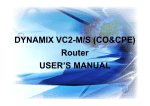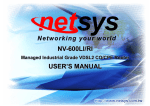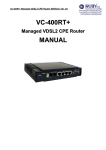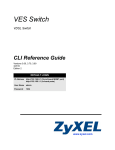Download VDSL2 VC-400LT&VC-400RT Router USER'S MANUAL
Transcript
VDSL2 VC-400LT&VC-400RT Router USER’S MANUAL VDSL2 VC-400LT & VC-400RT Router USER’S MANUAL Ver.A13 VDSL2 Point to Point Solution VDSL2 (Very-High-Bit-Rate Digital Subscriber Line 2, ITU-T G.993.2 Standard) is an access technology that exploits the existing infrastructure of copper wires that were originally deployed for POTS services. It can be deployed from central offices, from fibre-fed cabinets located near the customer premises or within buildings. ITU-T G.993.2 VDSL2 is the newest and most advanced standard of DSL broadband wireline communications. Designed to support the wide deployment of Triple Play services such as voice, video, data, high definition television (HDTV) and interactive gaming. VDSL2 enables operators and carriers to gradually, flexibly and cost efficient upgrade on existing xDSL-infrastructure. ITU-T G.993.2 (VDSL2) is an enhancement to G.993.1 VDSL that permits the transmission of asymmetric and symmetric (Full-Duplex) aggregate data rates up to 200 Mbit/s on twisted pairs using a bandwidth up to 30 MHz. VDSL2 deteriorates quickly from a theoretical maximum of 250 Mbit/s at 'source' to 100 Mbps at 0.3 km and 50 Mbps at 1 km, but degrades at a much slower rate from there and still outperforms VDSL. Starting from 1.6 km its performance is equal to ADSL2+. 1 VDSL2 VC-400LT & VC-400RT Router USER’S MANUAL Ver.A13 Safety Warnings For your safety, be sure to read and follow all warning notices and instructions before device use. • DO NOT open the device or unit. Opening or removing covers can expose you to dangerous high voltage points or other risks. ONLY qualified service personnel can service the device. Please contact your vendor for further information. • Use ONLY the dedicated power supply for your device. Connect the power cord or power adaptor to the right supply voltage (110V AC in North America or 230V AC in Europe). • DO NOT use the device if the power supply is damaged as it might cause electrocution. • If the power supply is damaged, remove it from the power outlet. • DO NOT attempt to repair the power supply. Contact your local vendor to order a new power supply. • Place connecting cables carefully so that no one will step on them or stumble over them. DO NOT allow anything to rest on the power cord and do NOT locate the product where anyone can work on the power cord. • DO NOT install nor use your device during a thouderstorm. There may be a remote risk of electric shock from lightning. • DO NOT expose your device to dampness, dust or corrosive liquids. • DO NOT use this product near water, for example, in a wet basement or near a swimming pool. • Connect ONLY suitable accessories to the device. • Make sure to connect the cables to the correct ports. • DO NOT obstruct the device ventilation slots, as insufficient airflow may harm your device. • DO NOT store things on the device. • DO NOT use the device outside, and make sure all the commections are indoors. There may be a remote risk of electric shock from lightning. • Be careful when unplugging the power, because the transformer may be very hot. • Keep the device and all its parts and accessories out of children’s reach. • Clean the device using a soft and dry cloth rather than liquid or atomizers. Power off the equipment before cleansing it. • This product is recyclable. Dispose of it properly. 2 VDSL2 VC-400LT & VC-400RT Router USER’S MANUAL Ver.A13 Table of Contents Safety Warnings….2 1.Unpacking Information….6 1.1 Check List6 2. Complete Installation….6 2.1 Hardware Installation….6 2.2 Pre-installation Requirements….6 2.3 General Rules….7 2.4 VDSL2 VC-400LT/VC-400RT Router Connections….7 3. Hardware Description….9 3.1 Front Panel….9 3.2 Six LED indicators….9 3.3 Front Indicators….9 3.4 Rear Panel….10 3.5 Power On….10 4. Configure the VDSL2 VC-400LT/VC-400RT Router Via Web Browser….11 4.1 Login….11 4.2 Select the Menu Level….12 4.3 Select Advanced Setup….13 4.4 Select LAN….14 4.4.1 Select LAN Settings and set the IP Address….15 4.4.2 Restart the Settings Dialog….17 5. Configure the VDSL2 VC-400LT/VC-400RT Router via Console….18 5.1 Setup on Hyperterminal….18 5.2 Reset the system to default configuration….19 6. Building a VDSL2 System….19 3 VDSL2 VC-400LT & VC-400RT Router USER’S MANUAL Ver.A13 6.1 Connect the VDSL2 VC-400LT and VC-400RT ROUTER to the Line….19 6.2 Connect the VDSL2 VC-400LT and VC-400RT ROUTER to LAN Devices….20 6.3 Run Demos and Tests….20 7. Operating the VDSL2 System….20 7.1 Configuration Settings….20 7.1.1 Channel Configuration….21 7.1.2 Line Configuration….23 7.1.3 Profile Configuration….23 7.1.4 Band Configuration….29 7.1.5 Loop Back….29 7.1.6 Line Activation….31 7.2 Status Displays….32 7.2.1 Line Status….32 7.2.2 Channel Status….33 7.2.3 Version Info….34 7.2.4 SNR Graphs….34 7.2.5 BitsGraphs….36 8. Configuration Interface of the Router….36 8.1 Logging in to the VDSL2 CO/VC-400RT Router….37 8.2 Setup Wizard and Advanced Setup….38 8.2.1 Setup Wizard….39 8.2.2 Advanced Setup….39 8.2.3 System….41 8.2.3.1 Administrator Settings….42 8.2.3.2 Firmware Upgrade….43 8.2.3.3 Device Mode….44 8.2.3.4 System Status….45 8.2.3.5 Reboot….46 8.2.3.6 Reset system….47 8.2.4 WAN….48 8.2.4.1 Dynamic IP….48 8.2.4.2 IP Settings….49 8.2.4.3 PPPoE….51 8.2.4.4 DNS….52 8.2.5 LAN….53 8.2.5.1 LAN Settings….54 8.2.5.2 DHCP Client List….56 8.2.5.3 LAN Switch Port Setting….57 8.2.5.4 LAN Port Status….57 8.2.6 NAT….58 8.2.6.1 Virtual Server….59 8.2.6.2 Port Mapping….60 8.2.6.3 DMZ….61 4 VDSL2 VC-400LT & VC-400RT Router USER’S MANUAL Ver.A13 8.2.7 Firewall…62 8.2.7.1 Firewall Options….62 8.2.7.2 Client Filtering….63 8.2.7.3 MAC Control….65 8.2.8 Route Settings….66 8.2.8.1 Static Routing….66 8.2.8.2 Routing Table List….67 8.2.9 UPnP Setting….67 8.2.9.1 Settings….68 Appendix A: Product Features & Specification….69 Features:….69 Specifications:…71 Appendix B: Troubleshooting….72 Appendix C : Compliance and Safety Information….73 Warranty….75 5 VDSL2 VC-400LT & VC-400RT Router USER’S MANUAL Ver.A13 1.Unpacking Information 1.1 Check List Carefully unpack the package and check its contents against the checklist. Package Contents z z z z z z VDSL2 Router (VC-400LT / VC-400RT) Two rubber feet User’s Manual AC to DC 12V Power Adapter RJ-45 cable RJ-11 cable Please inform your dealer immediately for any missing or damaged parts. If possible, retain the carton including the original packing materials. Use them to repack the unit in case there is a need to return for repair. 2. Complete Installation 2.1 Hardware Installation This chapter describes how to install the VDSL2 VC-400LT/VC-400RT Router and establishes network connections. This may install the VDSL2 VC-400LT/VC-400RT Router on any level surface (e.g, a table or shelf). However, please take note of the following minimum site requirements before you begin. 2.2 Pre-installation Requirements Before the start actual hardware installation, make sure to provide the right operating environment, including power requirements, sufficient physical space 6 VDSL2 VC-400LT & VC-400RT Router USER’S MANUAL Ver.A13 and proximity to other network devices that are to be connected. Verify the following installation requirement: • Power requirements: DC12V/1A or above. • The VDSL2 VC-400LT/VC-400RT Router should be located in a cool dry place, with at least 10cm/4in of space at the front and back for ventilation. • Place the VDSL2 VC-400LT/VC-400RT Router out of direct sunlight, and away from heat sources or areas with a high amount of electromagnetic interference. • Check if network cables and connectors needed for installation are available 2.3 General Rules Before making any connections to the VDSL2 VC-400LT/VC-400RT Router, note the following rules: • Ethernet Port (RJ-45) All network connections to the Router Ethernet port must be made using Category 5 UTP for 100Mbps; Category 3, 4 UTP for 10Mbps No more than 100 meters of cabling may be use between the MUX or HUB and an end node. • Phone Port (RJ-11) All Phone set connections to the RJ-11 Port must use 24~26 Gauge phone wiring. 2.4 VDSL2 VC-400LT/VC-400RT Router Connections The VDSL2 VC-400LT/VC-400RT Router can be controlled by a PC. For this purpose, a PC is needed with an Ethernet network interface and a DB-9 RS-232 serial interface. Two programs are required: A Web browser is mandatory and a terminal program should be available optionally. The board has several connectors. 7 VDSL2 VC-400LT & VC-400RT Router USER’S MANUAL Ver.A13 • 4 Ethernet RJ-45 jacks; the Auto MDIX feature of the port switches automatically between MDI and MDI-X (MDI – X = Media Dependant Interface - Crossover). Therefore straight Ethernet cables can be used. • 2 x RJ-11 jack (Line port is for VDSL client side connection to Line interface, Phone port is for connection to phone set or FAX machine). • 1 x Console port (access monitoring to operating system for firmware downloads, starting drivers and etc.) • 1 Power Supply (as described above) Figure 2.4 VDSL2 Basic Setup 8 VDSL2 VC-400LT & VC-400RT Router USER’S MANUAL Ver.A13 3. Hardware Description This section describes the important parts of the VDSL2 VC-400LT/VC-400RT Router. It features the front indicators and rear connectors. 3.1 Front Panel The following figure shows the front panel. Figure 3.1.1 VDSL2 VC-400LT ROUTER Figure 3.1.2 VDSL2 VC-400RT ROUTER 3.2 Six LED indicators At a quick glance of the front panel, it will be easy to tell if the router has power signal from its Ethernet RJ-45 port or there is phone line signal RJ-11port 3.3 Front Indicators The following table describes the LEDs. LEDs Color PWR Green Status Descriptions On The device is receiving the power and functioning properly. Off The device is not ready or has malfunctioned. 9 VDSL2 VC-400LT & VC-400RT Router USER’S MANUAL Ver.A13 E1~E4 (LAN) Green LINK / WAN Green On The device has a good Ethernet connection. Blinking The device is sending or receiving data. Off The LAN is not connected. On The Internet or network connection is up. Blinking The device is sending or receiving data. Off The Internet or network connection is down. 3.4 Rear Panel The following figure shows the rear connectors Figure 3.4 Rear Connectors VDSL2 VC-400LT/VC-400RT Router Rear Connectors Connectors Type Description Line RJ-11 For connecting to the VDSL2 Router Using a RJ-11 cable Phone RJ-11 For connecting to the POTS equipment or ISDN router E1~E4 RJ-45 For connecting to a Ethernet equipped device Console RS-232 For connecting to PC with RS-232 serial port over a D-SUB Cable 3.5 Power On Check the adapter is properly connected. Verify the power LED is steadily on. 10 VDSL2 VC-400LT & VC-400RT Router USER’S MANUAL Ver.A13 4. Configure the VDSL2 VC-400LT/VC-400RT Router Via Web Browser The VDSL2 VC-400LT/VC-400RT Router provides a built-in HTML based management interface that allow user configure the VDSL2 VC-400LT/VC-400RT Router via Internet Browser. Recommend using Internet Explorer 6.0 or later version and set screen resolution at 1024 x 768. In order to use the web browser configure the device, you may need to allow: • Web browser pop-up windows from your device. Web pop-up blocking is enabled by default in windows XP SP2. • JavaScripts. (Enabled by default) • Java permissions. (Enabled by default) Launch your web browser and input the IP address 192.168.16.249 (VDSL2 VC-400LT Router) or 192.168.16.250 (VDSL2 VC-400RT Router) in the Web page. 4.1 Login The default password is “admin“. The password is changeable in Administrator Settings. Figure 4.1 Login 11 VDSL2 VC-400LT & VC-400RT Router USER’S MANUAL Ver.A13 4.2 Select the Menu Level There is an easy Setup Wizard for end users at the VDSL2 VC-400RT Router and an Advanced Setup for more detail configurations. This manual attaches importance to the Advanced Setup. 12 VDSL2 VC-400LT & VC-400RT Router USER’S MANUAL Ver.A13 Figure 4.2 Select the Advanced Setup in the Entry Screen 4.3 Select Advanced Setup Select the Advanced Setup. The menu below will be used frequently. As an exercise and an example now the IP address will be set. 13 VDSL2 VC-400LT & VC-400RT Router USER’S MANUAL Ver.A13 Figure 4.3 Advanced Setup Attention: The settings in the following Chapter 4.4 only need to be performed in order to change LAN settings. Such a change may be necessary when connecting the VDSL2 VC-400LT/VC-400RT Router to a new control PC and/or in order to turn the IP address changed via a shell command into a default address for the next restart of the board. 4.4 Select LAN The menu below will not be used very often, but when connecting the VDSL2 VC-400LT/VC-400RT Router to a new control PC, one may want to go through the following steps in order to make the IP address previously set by ifconfig in the console or on some later occasion one may want to change it again without using the console then the menu below will be helpful. In order to set the IP address, click on “LAN Settings”. 14 VDSL2 VC-400LT & VC-400RT Router USER’S MANUAL Ver.A13 Figure 4.4 LAN menu 4.4.1 Select LAN Settings and set the IP Address The form below is used to change the IP address of the LAN port “adm0” in the VDSL2 VC-400LT/VC-400RT Router. The proposed IP address is either the default address of adm0 or it is the address changed by an ifconfig command via the shell running in the terminal. The Subnet Mask display can be ignored. In case the DHCP checkbox is checked, some additional data and options will be on display (see Chapter 8.2.5.1 on Page 70). The DHCP server is not required to work with VDSL2 in a lab environment. It recommend to uncheck the box if it is not unchecked already. 15 VDSL2 VC-400LT & VC-400RT Router USER’S MANUAL Ver.A13 Figure 4.4.1 LAN Settings Now the IP address either may be changed or left as it is. If it has been changed in the form or after it has been changed through console ifconfig command, it needs to be “APPLY” in order to make the displayed IP address new default address. 16 VDSL2 VC-400LT & VC-400RT Router USER’S MANUAL Ver.A13 4.4.2 Restart the Settings Dialog After the “APPLY” button has been hit, the displayed IP address “adm0” port will be stored in a non volatile memory on the VDSL2 VC-400LT/VC-400RT Router. Also, the Ethernet link between the control PC and the VDSL2 VC-400LT/VC-400RT Router will be re-initialized – even if the IP address has not been changed. Refresh the display of the HTTP browser running on the control PC and login again. Figure 4.4.2 Login Password The VDSL2 VC-400LT/VC-400RT Router is ready to be controlled by the control PC now. 17 VDSL2 VC-400LT & VC-400RT Router USER’S MANUAL Ver.A13 5. Configure the VDSL2 VC-400LT/VC-400RT Router via Console 5.1 Setup on Hyperterminal Open the Hyperterminal and set the baud rate to 115200, 8N1N to properly set the hyperterminal. 18 VDSL2 VC-400LT & VC-400RT Router USER’S MANUAL Ver.A13 Figure 5 Hyperterminal Configuration 5.2 Reset the system to default configuration. At the CLI command, write the command “rawaccess –e” to reset the system to default configuration. For it to take effect write the command “reboot” to restart the system. 6. Building a VDSL2 System First a quick overview on a complete setup of VDSL2 VC-400LT/VC-400RT Router. Figure 6 VDSL2 Application 6.1 Connect the VDSL2 VC-400LT and VC-400RT ROUTER to the Line The objective for VDSL2 is to pass high speed data over a twisted pair cable. In the setup, connects VDSL2 VC-400LT Router to VDSL2 VC-400RT Router through phone wire or line simulator or any other hardware representation of a cable network, with or without noise injection and crosstalk simulations. 19 VDSL2 VC-400LT & VC-400RT Router USER’S MANUAL Ver.A13 6.2 Connect the VDSL2 VC-400LT and VC-400RT ROUTER to LAN Devices In the setup, usually an Ethernet tester serves as representation of the LAN side as well as representation of the WAN side. 6.3 Run Demos and Tests The Ethernet tester may send data downstream as well as upstream. It also receives the data in order to check the integrity of the data transmission. Different data rates can be tested under different line conditions. 7. Operating the VDSL2 System After the VDSL2 system has been set up, one may want to configure the settings that are related to VDSL2. Configuration of operation modes, test modes (loop back) and the display of status information are supported by GUI (Graphical User Interface). 7.1 Configuration Settings Configure and start the VDSL2 VC-400LT Router (VC-400LT) and the VDSL2 VC-400RT Router (VC-400RT). • Configuration: As a minimum configuration, usually selecting the bandplan is required. See Chapter 7.1.3, Profile Configuration. • Next, both sides should be activated from the web interface. See Chapter 7.1.6, Line Activation • The connection status of the link can be monitored. See Chapter 7.2.1, Line Status 20 VDSL2 VC-400LT & VC-400RT Router USER’S MANUAL Ver.A13 7.1.1 Channel Configuration This function is for setting VDSL2 channel. Figure 7.1.1 Channel Configuration Menu Interleave delay function is used in digital data transmission technology to protect the transmission against noise issue and data error. If during transit more than a certain amount of data has been lost then the data cannot be correctly decoded. Short bursts of noise on the line can cause these 21 VDSL2 VC-400LT & VC-400RT Router USER’S MANUAL Ver.A13 data packets to become corrupt and the router has to re-request data which in turn can slow down the overall rate at which data is transmitted. Interleaving is a method of taking data packets, chopping them up into smaller bits and then rearranging them so that once contiguous data is now spaced further apart into a non continuous stream. Data packets are re-assembled by your router. The diagram below is an example of how interleaved traffic is transmitted. If your line is particularly susceptible to bursts of noise then interleaving should improve your VDSL2 experience simply because if you lose a whole batch of data then this could cause your router to loose sync with the exchange. Using Interleaving, the router is able to re-assemble the data or if necessary just re-request the part of the data that it is unable to recover. By increasing the interleave depth of each ports that are susceptible to noise, this will improve error performance and stability of marginal lines. Channel Configuration Settings Setting Description Channel Number To which bearer channel number shall the settings apply? z Channel 0 Direction To which direction shall the settings apply? z Upstream z Downstream Min Data Rate Minimum Payload Data Rate Max Data Rate Maximum Payload Data Rate Max Interleave Delay Maximum Interleave Delay ( set from 1 to 63ms) 22 VDSL2 VC-400LT & VC-400RT Router USER’S MANUAL Ver.A13 Note: The Reboot is needed for saving the new settings. 7.1.2 Line Configuration Figure 7.1.2 Line Configuration Menu for SNR Margin Selection Line Configuration Setting Description Direction Select the target direction. Target SNRM Set the required SNR Margin *10 (60=6dB) 7.1.3 Profile Configuration For this function, VDSL2 VC-400LT/VC-400RT Router provides world wide telecom standard band plan, such as meet European telecom standard band plan 998(17a), USA telecom standard band plan 997(8a, 8b) and APAC Telecom standard band plan (30a) etc. 23 VDSL2 VC-400LT & VC-400RT Router USER’S MANUAL Ver.A13 Annex A specifies bandplans for the North American region and enables VDSL2 VC-400LT/VC-400RT Router to be deployed with traditional POTS telephony or in an all-digital mode. Annex B specifies bandplans for Europe and enables VDSL2 VC-400LT/VC-400RT Router deployment with underlying POTS and ISDN services. Annex C allows VDSL2 VC-400LT/VC-400RT Router to coexist with TCM-ISDN services, found primarily in APAC. VDSL2 VC-400LT/VC-400RT Router has numerous configuration profiles and bandplans to meet regional service provider requirements. The frequency bandwidth has increased to 30 MHz, with configuration options at 8.5 MHz, 12 MHz, 17.7 MHz and 30 MHz. Band profile and band plan can only be configured at VDSL2 VC-400LT Router as VDSL2 VC-400RT Router will auto-follow up on the settings of VDSL2 VC-400LT Router. The only thing that VDSL2 VC-400RT Router has to be configured so that the routers will link is the tone mode. However, the default tone mode for VDSL2 VC-400LT/VC-400RT Router is V43, so at default there’s no need to change the tone mode unless it is required by the telecom companies to use different tone mode. Another important thing is that band profile and band plan setting must be compatible to each other if not access error will show when applied. Please deactivate and activate once the setting has been changed. 24 VDSL2 VC-400LT & VC-400RT Router USER’S MANUAL Ver.A13 25 VDSL2 VC-400LT & VC-400RT Router USER’S MANUAL Ver.A13 Figure 7.1.3.1 Profile Configuration Figure 7.1.3.2 Band Profile and Plan Setup Error 26 VDSL2 VC-400LT & VC-400RT Router USER’S MANUAL Ver.A13 Figure 7.1.3.3 Band Profile Region The following shows the band profile and band plan compatibility: Band Profile List Band Plan List 0 VDSL2 Profile8a 9 Annex A M1_EU32 1 VDSL2 Profile8b 10 Annex A M9_EU64 2 VDSL2 Profile8c 11 Annex B 997-M2x-A (B05) 3 VDSL2 Profile8d 12 Annex B 997-M2x-M (B06) 4 VDSL2 Profile12a 13 Annex B 997-M1c-A-7 (B07) 5 VDSL2 Profile12b 14 Annex B 998-M1x-B (B08) 6 VDSL2 Profile17a 15 Annex B 998-M2x-A (B10) 7 VDSL2 Profile17b 16 Annex B 998-M2x-M (B11) 8 VDSL2 Profile30a 17 Annex B 998-M2x-B (B12) 18 Annex B 998-M2x-NUS0 (B13) 19 Annex C 20 Annex C_8K 21 Annex B 997-M2x-NUS0 Annex C 1M1 22 23 Annex C_8K 1M1 24 Annex B 998E17-M2x-A 25 Annex B 998E17-M2x-NUS0 27 VDSL2 VC-400LT & VC-400RT Router USER’S MANUAL Ver.A13 Note: O = Compatible ; X = Not Compatible The following phone cable distance and data rates are possible according to the band profile and band plan setup: Default plan profile and band plan = 30a and C8K At distance 0-350m, data rates are at 100Mbps for both downstream and upstream 350-450m, data rates are at 70-85/40Mbps for downstream/upstream 450-600m at 40-60/10Mbps for downstream/upstream 600-900m at 20-40/1-5Mbps for downstream/upstream Note: Using Band profile 30a and band plan C8K for distances beyond 900m is not recommended Alternative band profile and band plan = 8d and M1_EU32 At distance 0-800m, data rates are at 60-80/15Mbps for both downstream/upstream. 800-1200m, data rates are at 30-50/5-10Mbps for downstream/upstream 1200-1500m, data rates are at 30/2-5Mbps for downstream/upstream Note: Using Band profile 8d and band plan M1_EU32 for distances beyond 28 VDSL2 VC-400LT & VC-400RT Router USER’S MANUAL Ver.A13 1500m is not recommended Additional: Downstream: Traffic from Transmitter to Receiver Upstream: Traffic from Receiver to Transmitter 7.1.4 Band Configuration This function is for setting tones for each band. This function can only be seen at VDSL2 VC-400LT Router web management only. Figure 7.1.4 Band Configuration 7.1.5 Loop Back The loop back testing function for checking phone wire link problem: 1. System Loop. 2. Line Side Loop 29 VDSL2 VC-400LT & VC-400RT Router USER’S MANUAL Ver.A13 Figure 7.1.5 Loop Back Activation/Deactivation Menu Loop Back Setting Description Channel No. To which bearer channel number shall the settings apply? Channel 0 Loop System loop or line side loop State Activate or deactivate loop back within the transmission convergence layer 30 VDSL2 VC-400LT & VC-400RT Router USER’S MANUAL Ver.A13 7.1.6 Line Activation This function is for enable/disable VDSL2 port. Figure 7.1.6 Activation and Deactivation of the Line Line Activation/Deactivation Setting Description Line Activate or deactivate the line. (Select the activity and the press the APPLY button.) 31 VDSL2 VC-400LT & VC-400RT Router USER’S MANUAL Ver.A13 7.2 Status Displays 7.2.1 Line Status This function provides SNR value for checking phone wiring quality. Figure 7.2.1 Line Status Display: Actual SNR The following status messages may occur: not_initialized, exception, idle request, idle, silent request, silent, handshake, full init, discovery, training, analysis, exchange, showtime no sync, showtime tc sync, fast retrain, lowpower l2, loopdiagnostic, loopdiagnostic complete, resync, test, lowpower l3, unknown. 32 VDSL2 VC-400LT & VC-400RT Router USER’S MANUAL Ver.A13 7.2.2 Channel Status This function shows VDSL2 port status. Figure 7.2.2 Channel Status Display: Data Rate, Delay, Error Counters and Impulse Noise Protection 33 VDSL2 VC-400LT & VC-400RT Router USER’S MANUAL Ver.A13 7.2.3 Version Info This function shows hardware and firmware version. Figure 7.2.3 Display of Version Data 7.2.4 SNR Graphs When VDSL2 VC-400LT Router links with VDSL2 VC-400RT Router, this graph will show the SNR value for each band. 34 VDSL2 VC-400LT & VC-400RT Router USER’S MANUAL Ver.A13 Figure 7.2.4 Display of SNR per Carrier 35 VDSL2 VC-400LT & VC-400RT Router USER’S MANUAL Ver.A13 7.2.5 BitsGraphs When VDSL2 VC-400LT Router links with VDSL2 VC-400RT Router, this graph will show the bits value for each tone. Figure 7.2.5 Display Bits Per Tone Graph 8. Configuration Interface of the Router This section explains how to configure the router section of the VDSL2 VC-400LT/VC-400RT Router using its web-based configuration. The part of the circuitry as well as the router configuration menu has been ported from that of the reference kit to the VDSL2 VC-400LT/VC-400RT Router reference board. As for the menu, there are only a few differences: The “adm1” port now is the port to the VDSL2 side. The port on the LAN is “adm0”. It supports four Ethernet connections. z The IP addresses are used in this chapter are different from the examples in the previous chapters. z The password used in this chapter is different from the examples in the previous chapters. z 36 VDSL2 VC-400LT & VC-400RT Router USER’S MANUAL Ver.A13 8.1 Logging in to the VDSL2 VC-400LT/VC-400RT Router To log on to the VDSL2 VC-400LT/VC-400RT Router Web Application, you must have a valid password. The Administrator creates the log on user with its password. When one log on to the VDSL2 VC-400LT/VC-400RT Router Web Application, the LOGIN PASSWORD window is displayed as shown in Figure 8.1. Figure 8.1 VDSL2 VC-400LT/VC-400RT Router Web Application In the LOGIN PASSWORD window: 37 VDSL2 VC-400LT & VC-400RT Router USER’S MANUAL Ver.A13 1. Enter the password in the Password text box. For an Admin user, the default password is “admin”. 2. Click LOGIN to begin the configuration or click CANCEL in the LOGIN PASSWORD window to cancel this log on operation. 8.2 Setup Wizard and Advanced Setup There is an easy Setup Wizard for end users at the VDSL2 VC-400RT router and an Advanced Setup for more detail configurations for both VDSL2 VC-400LT/VC-400RT Router. This manual gives importance to the Advanced Setup. Figure 8.2 Select the Advanced Setup in the Entry Screen 38 VDSL2 VC-400LT & VC-400RT Router USER’S MANUAL Ver.A13 8.2.1 Setup Wizard The Setup Wizard is designed for ease-of-use in order to quickly configure the most common settings. The Admin can view the Setup Wizard link in the homepage. The wizard first step is to allow the admin to configure the system host settings displayed as shown in Figure 8.2.1 Figure 8.2.1 Setup Wizard’s First Step There are four steps to complete the wizard. Follow the instructions given in each step and enter the desired settings. 8.2.2 Advanced Setup Click on the Advanced Setup link in the homepage in case you want to configure a wider range of settings. Router setup are only located at VDSL2 VC-400RT ROUTER. So the WAN, NAT, Firewall and UPnP are only seen at VDSL2 VC-400RT router advanced setup menu. The following configuration options are displayed in the left navigation bar, as shown in Figure 8.2.2. • System • WAN (VDSL2 VC-400RT Router only) • LAN • NAT (VDSL2 VC-400RT Router only) • Firewall (VDSL2 VC-400RT Router only) 39 VDSL2 VC-400LT & VC-400RT Router USER’S MANUAL Ver.A13 • Route • UPnP (VDSL2 VC-400RT Router only) • VDSL2 Figure 8.2.2 Advanced Setup 40 VDSL2 VC-400LT & VC-400RT Router USER’S MANUAL Ver.A13 8.2.3 System The System link can be viewed in the left navigation bar. The following are the options available under System, as shown in Figure 8.2.3. • Administrator Settings • Firmware Upgrade • Device Mode (VDSL2 VC-400RT ROUTER only) • System Status • Reboot • Reset System Figure 8.2.3 System in the Left Navigator Bar 41 VDSL2 VC-400LT & VC-400RT Router USER’S MANUAL Ver.A13 8.2.3.1 Administrator Settings To add a user or change user’s password, click on the Administrator Settings link in the left navigation bar. A screen is displayed as shown in Figure 8.2.3.1. Figure 8.2.3.1 Administrator Settings Configuration While adding a user, each user must assign a separate port. Hence the number of users that can be added to the system depends on the number of ports available on the VDSL2 VC-400LT/VC-400RT Router. 42 VDSL2 VC-400LT & VC-400RT Router USER’S MANUAL Ver.A13 The screen contains the following details: Fields in User Setting Field Description Current Password This is the password associated with the administrator. This is enabled only for the user Administrator login. Password This is the password of the login administrator. Re-type Password Auto-Logout Time This is the password verification. The auto-logout time, at least one minute. • Click APPLY to save the information that has been entered. • Click CANCEL to exit from this page without saving the changes. 8.2.3.2 Firmware Upgrade To update the system firmware, click on the Firmware Upgrade link in the left navigation bar. A screen is displayed as shown in 8.2.3.2 43 VDSL2 VC-400LT & VC-400RT Router USER’S MANUAL Ver.A13 Figure 8.2.3.2 Firmware Update The screen contains the following detail: • Click APPLY to start the firmware update. • Click Browse to select a specified file name to change the File Name. 8.2.3.3 Device Mode The ADM5120 network processor used in the reference system is able to act as either a switch or a router. Clicking on Device Mode on the left navigation bar allows the user to change the mode of operation, as shown in the following figure. 44 VDSL2 VC-400LT & VC-400RT Router USER’S MANUAL Ver.A13 Figure 8.2.3.3 Device Mode The default setting is in Switch mode, it is not necessary to change the setting in most of the case. In situations, which devices (e.g. PC, Server, VoIP) connected to VC-400RT requires Router function. Hence, set the VC-400RT on Router mode. 8.2.3.4 System Status To view system status, click on the System Status link in the left navigation bar. A screen is displayed as shown in Figure 8.2.3.4 45 VDSL2 VC-400LT & VC-400RT Router USER’S MANUAL Ver.A13 Figure 8.2.3.4 Status Window 8.2.3.5 Reboot To reboot the unit, click on the Reboot link in the left navigation bar. A screen is displayed as shown in Figure 8.2.3.5. 46 VDSL2 VC-400LT & VC-400RT Router USER’S MANUAL Ver.A13 Figure 8.2.3.5 Reboot VDSL2 VC-400LT/VC-400RT Router • Click Reboot to restart the unit. 8.2.3.6 Reset system To reset the system, click on the Reset link in the left navigation bar. A screen is displayed as shown in Figure 8.2.3.6. Figure 8.2.3.6 Reset VDSL2 VC-400LT/VC-400RT Router • Click Reset to restart the system to default configuration. 47 VDSL2 VC-400LT & VC-400RT Router USER’S MANUAL Ver.A13 8.2.4 WAN The WAN settings can be viewed in the left navigation bar of VDSL2 VC-400RT Router only. The following are the options available under WAN, as shown Figure 8.2.4: • Dynamic IP • IP Settings • PPPoE • DNS Figure 8.2.4 WAN Setting in Left Navigator Bar 8.2.4.1 Dynamic IP To configure the WAN interface to dynamically obtain an IP Address, click on the Dynamic IP link in the left navigation bar. A screen is displayed as shown in Figure 8.2.4.1. 48 VDSL2 VC-400LT & VC-400RT Router USER’S MANUAL Ver.A13 Figure 8.2.4.1 Dynamic IP Configuration The screen contains the following details: • Click APPLY to save the information that has been entered. • Click CANCEL to exit from this page. 8.2.4.2 IP Settings To configure the WAN interface to use a Static IP Address, click on the Static IP link in the left navigation bar. A screen is displayed as shown in Figure 8.2.4.2. 49 VDSL2 VC-400LT & VC-400RT Router USER’S MANUAL Ver.A13 Figure 8.2.4.2 Static IP Configuration The screen contains the following details: Fields in Static IP Field Description IP Address assigned by your ISP Enter the IP Address of VDSL2 VC-400LT/VC-400RT Router. Enter the Subnet Mask of VDSL2 VC-400LT/VC-400RT Router. Enter the Gateway address of the VDSL2 VC-400LT/VC-400RT Router. Provides more IP Addresses of the WAN interface. Select the check box to enable this option. A screen is displayed as shown in Figure 41. Click Add to add IP Address and Subnet Mask. Subnet Mask ISP Gateway Address Does ISP provide more IP Address IP Pool Starting Address Enter the starting IP Pool Address. IP Pool Ending Address Enter the ending IP Pool Address. Lease Time Enter the Lease Time from half hour to two weeks. Local Domain Name Enter the Local Domain Name but is optional. 50 VDSL2 VC-400LT & VC-400RT Router USER’S MANUAL Ver.A13 • Click APPLY to save the information that has been entered. • Click CANCEL to exit from this page without saving the changes. 8.2.4.3 PPPoE To configure the WAN interface to use PPPoE, click on the PPPoE link in the left navigation bar. A screen is displayed as shown in Figure 8.2.4.3. Figure 8.2.4.3 PPPoE Configuration The screen contains the following details: Fields in PPPoE Field Description User Name Enter a name to use the PPPoE session. Password Enter the password of the login user. Retype Password Enter the password again to reconfirm. Service Name Enter a service name. Field Description 51 VDSL2 VC-400LT & VC-400RT Router USER’S MANUAL Ver.A13 MTU Enter the maximum connection units of the PPPoE. The MTU range is 1400 to 1492 bytes. By default, it is 1492. Maximum Idle Time This is the period of time required to keep the connection alive if no packets are transmitted. If no packets are transmitted between LAN port and WAN port or between VDSL2 VC-400LT/VC-400RT Router and WAN, the connection is disconnected after the 'Maximum idle time. If the Auto-reconnect check box is selected, the PPP connection is re-established if there is some data that is received from the upper layers to be transmitted on this link. • Click APPLY to save the information that has been entered. • Click CANCEL to exit from this page without saving the changes. 8.2.4.4 DNS To configure the DNS address, click on the DNS link in the left navigation bar. A screen is displayed as shown in Figure 8.2.4.4: 52 VDSL2 VC-400LT & VC-400RT Router USER’S MANUAL Ver.A13 Figure 8.2.4.4 DNS Configuration The screen contains the following details: Fields in DNS Field Description Domain Address Name Server(DNS) Secondary DNS Address(optional) Enter the DNS address of the primary DNS server. Enter the address of the secondary DNS server, if available. • Click APPLY to save the information that has been entered. • Click CANCEL to exit from this page without saving the changes. 8.2.5 LAN The LAN Setting can be viewed in the left navigation bar. The following are the options available under LAN, as shown in Figure 8.2.5: 53 VDSL2 VC-400LT & VC-400RT Router USER’S MANUAL Ver.A13 • LAN Settings • DHCP Client List • LAN Switch Port Setting • LAN Port Status Figure 8.2.5 LAN in Left Navigator Bar 8.2.5.1 LAN Settings Attention: For the VDSL2 VC-400LT/VC-400RT Router, it is recommended to select a simple IP setting suitable to controlled lab environments. Set a static IP address and don’t use DHCP. The required steps are explained in Chapter 4.4.1 on Page 21! To configure the LAN interface, click on the LAN Settings link in the left navigation bar. A screen is displayed as shown in Figure 8.2.5.1 in case of the VDSL2 VC-400LT/VC-400RT Router. 54 VDSL2 VC-400LT & VC-400RT Router USER’S MANUAL Ver.A13 Figure 8.2.5.1 LAN Settings The screen contains the following details: Fields in LAN Settings Field Description Enter the LAN interface IP Address of VDSL2 VC-400LT/VC-400RT Router. Enter the LAN Subnet Mask of VDSL2 Subnet Mask VC-400LT/VC-400RT Router. Enable or disables the DHCP Server of the VDSL2 The Gateway acts as DHCP VC-400LT/VC-400RT Router. Select the check-box to Server enable this option. IP Address • Click APPLY to save the information that has been entered. • Click CANCEL to exit from this page without saving the changes. 55 VDSL2 VC-400LT & VC-400RT Router USER’S MANUAL Ver.A13 8.2.5.2 DHCP Client List To view the DHCP client list, click on the DHCP Client List link in the left navigation bar. A screen is displayed to list all DHCP client connection with IP Address and MAC Address as shown in Figure 8.2.5.2. Figure 8.2.5.2 DHCP Client List 56 VDSL2 VC-400LT & VC-400RT Router USER’S MANUAL Ver.A13 8.2.5.3 LAN Switch Port Setting To view the All LAN Port Setting, click on the All LAN Port Setting link in the left navigation bar. A screen is displayed to all LAN Port Setting as shown in Figure 8.2.5.3. Figure 8.2.5.3 DHCP Client List 8.2.5.4 LAN Port Status The following information provides a view of the current Ethernet ports status of the unit 57 VDSL2 VC-400LT & VC-400RT Router USER’S MANUAL Ver.A13 Figure 8.2.5.4 LAN Port Status 8.2.6 NAT The NAT Settings can be viewed in the left navigation bar of VDSL2 VC-400RT Router only. The following are the options available under NAT, as shown in Figure 8.2.6: • Virtual Server • Port Mapping • DMZ 58 VDSL2 VC-400LT & VC-400RT Router USER’S MANUAL Ver.A13 Figure 8.2.6 NAT in Left Navigator Bar 8.2.6.1 Virtual Server To configure virtual server, click on the Virtual Server link in the left navigation bar. A screen is displayed as shown in Figure 8.2.6.1: Figure 8.2.6.1 Virtual Server Configuration The screen contains the following details: 59 VDSL2 VC-400LT & VC-400RT Router USER’S MANUAL Ver.A13 Fields in Virtual Server Field Description Private IP Enter a private IP Address of specified entry. Private Port Enter a private Port number of the specified entry. Type Select virtual server protocol type of the specified entry. Public Port Enter a public port number of the internet user to access the virtual server. Enabled Enable the specified entry of the virtual server. • Click APPLY to save the information that has been entered. • Click CANCEL to exit from this page without saving the changes. 8.2.6.2 Port Mapping To configure Port Mapping, click on the Port Mapping link in the left navigation bar. A screen is displayed as shown in Figure 8.2.6.2: Figure 8.2.6.2 Port Mapping Configuration 60 VDSL2 VC-400LT & VC-400RT Router USER’S MANUAL Ver.A13 The screen contains the following details: Fields in Port Mapping Field Description Server IP Enter the IP Address of a specified local machine. Mapping Port Assign a range of port or specific port number to route the packets. Enabled Enable a specified entry of the Port Mapping. • Click APPLY to save the information that has been entered. • Click CANCEL to exit from this page without saving the changes. 8.2.6.3 DMZ To configure the DMZ, click on the DMZ link in the left navigation bar. A screen is displayed as shown in Figure 8.2.6.3: Figure 8.2.6.3 DMZ Configuration The screen contains the following details: 61 VDSL2 VC-400LT & VC-400RT Router USER’S MANUAL Ver.A13 Fields in DMZ Field Description Enable Enable or disable the DMZ setting of VDSL2 VC-400LT/VC-400RT Router. Select the check box to enable this option. IP Address Enter IP Address of the DMZ host. • Click APPLY to save the information that has been entered. • Click CANCEL to exit from this page without saving the changes. 8.2.7 Firewall The Firewall Settings can be viewed in the left navigation bar of VDSL2 VC-400RT Router only. The following are the options available under Firewall, as shown in Figure 8.2.7: • Firewall Options • Client Filter MAC Control • MAC Control Figure 8.2.7 Firewall in Left Navigator Bar 8.2.7.1 Firewall Options 62 VDSL2 VC-400LT & VC-400RT Router USER’S MANUAL Ver.A13 To enable the firewall options, click on the Firewall Options link in the left navigation bar. A screen is displayed as shown in Figure 8.2.7.1: Figure 8.2.7.1 Firewall Options Configuration The screen contains the following details: Fields in Firewall Options Field Enable Protect Description Hacker Attack Select the check box to log and drop all the hacker attack events. Discard PING from WAN Discard Gateway PING Select the check box to drop all PING from the WAN side. the Select the check box to drop all PING to VC-400LT/VC-400RT Router packet for the LAN side. Drop Port Scan Select the check box to drop all the port scan packets. • Click APPLY to save the information that has been entered. • Click CANCEL to exit from this page without saving the changes. 8.2.7.2 Client Filtering 63 VDSL2 VDSL2 VC-400LT & VC-400RT Router USER’S MANUAL Ver.A13 To enable Client Filter, click on the Client Filter link in the left navigation bar. A screen is displayed as shown in Figure 8.2.7.2. Figure 8.2.7.2 Client Filter Configuration The screen contains the following details: Fields in Client Filter Field Description Enable Client Filter Enable or disable the Client Filter feature of VDSL2 VC-400LT&VC-400RT Router. Select the check box to enable this option. IP Enter the filter IP Address range of the local machines under VDSL2 VC-400LT&VC-400RT Router. Port Enter the filter Port number range of the local machines under VDSL2 VC-400LT&VC-400RT Router. Type Select TCP or UDP to filter the protocol type packets from the local machines. Enable Provides more IP Addresses of the WAN interface. 64 VDSL2 VC-400LT & VC-400RT Router USER’S MANUAL Ver.A13 • Click APPLY to save the information that has been entered. • Click CANCEL to exit from this page without saving the changes. 8.2.7.3 MAC Control To configure MAC Control, click on the MAC Control link in the left navigation bar. A screen is displayed as shown in Figure 8.2.7.3 Figure 8.2.7.3 MAC Control Configuration The screen contains the following details: Fields in MAC Control Field Description MAC Address Control Enable or disable the MAC address control. Block Connection Internet MAC Address to Enable or disable block status. If the check box is selected, it blocks the specified MAC address. Assign the blocking MAC address for local machine. • Click APPLY to save the information that has been entered. • Click CANCEL to exit from this page without saving the changes. 65 VDSL2 VC-400LT & VC-400RT Router USER’S MANUAL Ver.A13 8.2.8 Route Settings The Route Settings can be viewed in the left navigation bar. The following are the options available under Route, as shown in Figure 8.2.8: • Static Routing • Routing Table List Figure 8.2.8 Route in Left Navigator Bar 8.2.8.1 Static Routing To setup Static Routing, click on the Static Routing link in the left navigation bar. A screen is displayed as shown in Figure 8.2.8.1. 66 VDSL2 VC-400LT & VC-400RT Router USER’S MANUAL Ver.A13 Figure 8.2.8.1 Static Routing Configuration The screen contains the following details: Fields in Static Routing Field Description Destination LAN IP Enter the IP Address of routing entry. Subnet Mask Enter the Subnet Mask of routing entry. Gateway Enter the Gateway address of routing entry. • Click Add to add the information that has been entered. 8.2.8.2 Routing Table List To view the Routing entry table list of VDSL2 VC-400LT/VC-400RT Router, click on the Routing Table by link in the left navigation bar. A screen is displayed as shown in Figure 8.2.8.2. Figure 8.2.8.2 Routing Table List The screen contains the following details: • Click Refresh to update VC-400LT/VC-400RT Router. 8.2.9 UPnP Setting 67 currently routing list of the VDSL2 VDSL2 VC-400LT & VC-400RT Router USER’S MANUAL Ver.A13 The UPnP Settings can be viewed in the left navigation bar of VDSL2 VC-400RT Router only. The following are the options available under UPnP, as shown in Figure 8.2.9. Figure 8.2.9 UPnP in Left Navigator Bar 8.2.9.1 Settings To enable or disable the UPnP Settings, click on the Settings link in the left navigation bar. A screen is displayed as shown in Figure 8.2.9.1. Figure 8.2.9.1 UPnP Configuration 68 VDSL2 VC-400LT & VC-400RT Router USER’S MANUAL Ver.A13 The screen contains the following details: Fields in UPnP Settings Field Description Enable UPnP To enable or disable UPnP Setting. Select the check box to Enable or Disable the UPnP function of SPEED-VDSL2 VC-400LT&VC-400RT Router. • Click APPLY at any time during configuration to save the information that you have entered. • Click CANCEL to exit from this page without saving the changes. Appendix A: Product Features & Specification Features: • Compliant with IEEE 802.3 & 802.3u Ethernet Standards • Compliant with G993.2 VDSL2 standards • Provides 4 x 10/100M auto-sensing RJ-45 Ethernet ports • Supports Bandwidth setup with 100 Mbps VDSL RJ-11 ports • POTS / ISDN Splitter port RJ-11 x 1 (Splitter on board) • Support Downstream Power Back-Off(DPBO) • Supports auto speed for VDSL2 port • Supports Web management (HTTP) • Supports TFTP • Supports Console (RS-232C) • Supports PPPOE • Supports NAT/DHCP/DMZ • Supports Firewall • Supports Route & Switch (Bridge) mode • Supports UPnP • Supports Loop back 69 VDSL2 VC-400LT & VC-400RT Router USER’S MANUAL Ver.A13 • Supports SNR indicator for checking phone wiring quality • Supports Interleave Delay to prevent against noise and data errors • Support 8a, 8b, 8c, 8d, 12a, 12b, 17a, 17b, and 30a band profile • Support 997, 998 band plan • Provides surge protection for VDSL2 port 70 VDSL2 VC-400LT & VC-400RT Router USER’S MANUAL Ver.A13 Specifications: Standard: IEEE802.3 standard IEEE802.3u standard Compliant G993.2 VDSL2 standard Interface: 4 * RJ-45 10/100Mbps Ethernet port 1 * RJ-11 connector for VDSL2 1 * RJ-11 connector for POTS/ISDN device Band Profile: 8a, 8b, 8c, 8d, 12a, 12b, 17a, 17b, 30a Band Plan: 997, 998 Max. Bandwidth: Symmetric 100 Mbps / 0.3 km LED indication: Power LED Link/Active Status for Ethernet port * 4 Link LED for VDSL2 port Switch method: Store and forward Console port: RS-232C/115200bps Flow control: Full duplex: IEEE 802.3x Half duplex: Back pressure Power Consumption: Operating Temperature: VDSL2 VC-400LT Router (LT): 5.52W VDSL2 VC-400RT Router (NT): 6.12W 0°C ~ 50°C (32°F ~ 122°F) Storage Temperature: -20°C ~ 70°C (-4°F ~ 158°F) Humidity: 10 to 90% (non-condensing) Weight: 0.96kg & 1.03kg (for metal case) Dimensions: 184 x 146 x 40 mm (7.2" x 5.74" x 1.57”) AC to DC adapter: Input range: 85VAC~240VAC/50~60Hz Output: 12VDC/1A EMI Compliant: CE, FCC, VCCI Chipset: Infineon 71 VDSL2 VC-400LT & VC-400RT Router USER’S MANUAL Ver.A13 Appendix B: Troubleshooting 1. Symptom: Connected the Co-Router with VC-400RT-Router within 300 meters RJ-11 phonecable got only less than 10 Mbit/s. Cause: Solution: Some testing program which is base on TCP/IP protocol such as FTP, Iperf, NetIQ, the bandwidth of testing outcome will be limited by TCP window size. We recommend to test VDSL2 bandwidth best by Smartbit equipment, if you don't have Smartbit, we recommend test that by IPERF program, and TCP window size must be setted max. 64k, the parameter as iperf –c server IP address –i 1 –t 50 –w 65535 for client side. 2. Symptom: VDSL2 VC-400LT router cannot link with VC-400RT router. Cause: Solution: 1. The VDSL2 VC-400LT/VC-400RT mode settings of VDSL2 router become unknown. 2. VDSL2 VC-400LT and VC-400RT router tone mode is different due to mixed use of new and old hardware VDSL2 routers. 1. Using the console, reboot the system and go to loader menu. Select set boot parameters and choose the VDSL2 VC-400LT/VC-400RT mode correctly. Choose “1” if it is VC-400LT router and “0” if it is VC-400RT router. Do not just press enter to skip the setting as it will not retain even if the setting is correct, then it will become unknown causing the VDSL2 router not to link. 2. Update the old hardware to D series firmware so that you can set the same tone mode for both VC-400LT and VC-400RT router. 3. Symptom: VDSL2 web management that uses public IP address cannot be accessed. Cause: It can be affected by some incoming traffic perhaps web crawlers, worms or other automated activity.. Solution: Open a command prompt and log in to telnet by writing “telnet xxx.xxx.xxx.xxx”, xxx is the IP address of your router, then write “cd /etc/rc.d/init.d” to go to this folder, then write “./httpd start” to open the web management, so that it can be accessed again. 72 VDSL2 VC-400LT & VC-400RT Router USER’S MANUAL Ver.A13 Appendix C : Compliance and Safety Information FCC Radio Frequency Interference Statement This equipment has been tested to comply with the limits for a computing device, pursuant to Part 15 of FCC rules. These limits are designed to provide reasonable protection against harmful interference when the equipment is operated in a commercial environment. This equipment can generate, use and radiate radio frequency energy and, if not installed and used in accordance with the instructions, may cause harmful interference to radio communications. However, there is no guarantee that interference will not occur in a particular installation. If this equipment does cause harmful interference to radio or television reception, which can be determined by turning the equipment off and on, the user is encouraged to try to correct the interference by taking one or more of the following measures: 1. Reorient or relocate the receiving antenna. 2. Increase the distance between the equipment and receiver. 3. The equipment and the receiver should be connected to outlets on separate circuits. 4. Consult the dealer or an experienced radio/television technician for help. Changes or modifications not expressly approved by the party responsible for compliance could void the user’s authority to operate the equipment. If this telephone equipment causes harm to the telephone network, the telephone company will notify you in advance that temporary discontinuance of service may be required. But if advance notice isn’t practical, the telephone company will notify the customer as soon as possible. Also, you will be advised of your right to file a complaint with the FCC if you believe it is necessary. The telephone company may make changes in its facilities, equipment, operations or procedures that could affect the proper functioning of your equipment. If they do, you will be notified in advance in order for you to make necessary modifications to maintain uninterrupted service. This equipment may not be used on coin service provided by the telephone company. Connection to party lines is subject to state tariffs. 73 VDSL2 VC-400LT & VC-400RT Router USER’S MANUAL Ver.A13 Important Safety Instructions Caution: The direct plug-in wall transformer serves as the main product for disconnecting. The socket outlet shall be installed near the product and be readily accessible. Caution: Use only the power supply included with this product. In the event the power supply is lost or damaged:In the United States, use only with CSA certified or UL listed Class 2 power supply, rated 12Vdc 1A or above. IN Europe, use only with CE certified power supply, rated 12Vdc 1A or above. Do not use this equipment near water, for example in a wet basement. Avoid using a telephone during an electrical storm. There may be a remote risk of electrical shock from lightning. Do not use the telephone to report a gas leak in the vicinity of the leaking area. If you experience trouble with this unit, please contact customer service at the address and phone listed below. DO NOT DISASSEMBLE THIS EQUIPMENT. It does not contain any user serviceable components. FCC Warning This equipment has been tested to comply with the limits for a Class A digital device, pursuant to Part 15 of the FCC Rules. These limits are designed to provide reasonable protection against harmful interference when the equipment is operated in a commercial environment. This equipment can generate, use, and radiate radio frequency energy and, if not installed and used in accordance with the instruction manual, may cause harmful interference to radio communications. Operation of this equipment in a residential area is likely to cause harmful interference in which case the user will be required to correct the interference at owner’s expense. CE Mark Warning This is a CE class A product. In a domestic environment, this product may cause radio interference in which case the user may be required to take adequate measures. 74 VDSL2 VC-400LT & VC-400RT Router USER’S MANUAL Ver.A13 Warranty The original owner of this package will be free from defects in material and workmanship for one year parts after purchase. For the warranty to apply, you must register your purchase by returning the registration card indicating the date of purchase. There will be a minimal charge to replace consumable components, such as fuses, power transformers, and mechanical cooling devices. The warranty will not apply to any products which have been subjected to any misuse, neglect or accidental damage, or which contain defects which are in any way attributable to improper installation or to alteration or repairs made or performed by any person not under control of the original owner. The above warranty is in lieu of any other warranty, whether express, implied, or statutory, including but not limited to any warranty of merchantability, fitness for a particular purpose, or any warranty arising out of any proposal, specification, or sample. We shall not be liable for incidental or consequential damages. We neither assume nor authorize any person to assume for it any other liability. WARNING: DO NOT TEAR OFF OR REMOVE THE WARRANTY STICKER AS SHOWN, OR THE WARRANTY IS VOID. 75

























































































